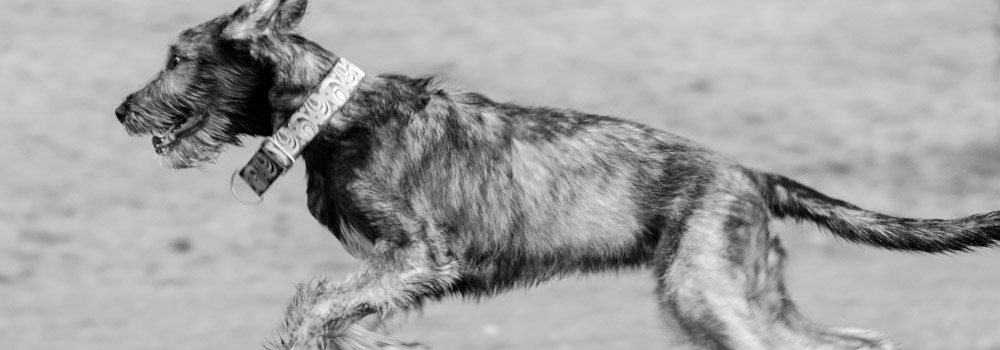The Irish Wolfhound is an ancient breed of the greyhound family. He was used to hunt wolves and elk and to accompany Irish nobles to war.
The instincts originally developed for the chase are still very much a part of the modern hounds. They need lots of food to grow, lots of space to stretch their legs at will and, above all, lots of love and human companionship to develop the loving temperament that is greater than their size and that has always been their heritage.
Breed Standard
Of great size and commanding appearance, the Irish Wolfhound is remarkable in combining power and swiftness with keen sight. The largest and tallest of the galloping hounds, in general type he is a rough-coated, Greyhound-like breed; very muscular, strong though gracefully built; movements easy and active; head and neck carried high, the tail carried with an upward sweep with a slight curve towards the extremity. The minimum height and weight of dogs should be 32 inches and 120 pounds; of bitches, 30 inches and 105 pounds; these to apply only to hounds over 18 months of age. Anything below this should be debarred from competition. Great size, including height at shoulder and proportionate length of body, is the desideratum to be aimed at, and it is desired to firmly establish a race that shall average from 32 to 34 inches in dogs, showing the requisite power, activity, courage and symmetry.
Head
Long, the frontal bones of the forehead very slightly raised and very little indentation between the eyes. Skull, not too broad. Muzzle, long and moderately pointed. Ears, small and Greyhound-like in carriage.
Neck
Rather long, very strong and muscular, well arched, without dewlap or loose skin about the throat.
Chest
Very deep. Breast, wide.
Back
Rather long than short. Loins arched.
Tail
Long and slightly curved, of moderate thickness, and well covered with hair.
Belly
Well drawn up.
Forequarters
Shoulders, muscular, giving breadth of chest, set sloping. Elbows well under, neither turned inwards nor outwards.
Leg
Forearm muscular, and the whole leg strong and quite straight.
Hindquarters
Muscular thighs and second thigh long and strong as in the Greyhound, and hocks well let down and turning neither in nor out.
Feet
Moderately large and round, neither turned inwards nor outwards. Toes, well arched and closed. Nails, very strong and curved.
Hair
Rough and hard on body, legs and head; especially wiry and long over eyes and underjaw.
Color & Markings
The recognized colors are gray, brindle, red, black, pure white, fawn, or any other color that appears in the Deerhound.
Faults
Too light or heavy a head, too highly arched frontal bone; large ears and hanging flat to the face; short neck; full dewlap; too narrow or too broad a chest; sunken or hollow or quite straight back; bent forelegs; overbent fetlocks; twisted feet; spreading toes; too curly a tail; weak hindquarters and a general want of muscle; too short in body. Lips or nose liver-colored or lacking pigmentation.
Points in Order of Merit
- Typical. The Irish Wolfhound is a rough- coated Greyhound-like breed, the tallest of the coursing hounds and remarkable in combining power and swiftness.
- Great size and commanding appearance.
- Movements easy and active.
- Head, long and level, carried high.
- Forelegs, heavily boned, quite straight; elbows well set under.
- Thighs long and muscular; second thighs, well muscled, stifles nicely bent.
- Coat, rough and hard, especially wiry and long over eyes and under jaw.
- Body, long, well-ribbed up, with ribs well sprung, and great breadth across hips.
- Loins arched, belly well drawn up.
- Ears, small, with Greyhound-like carriage.
- Feet, moderately large and round; toes, close, well arched.
- Neck, long, well arched and very strong.
- Chest, very deep, moderately broad.
- Shoulders, muscular, set sloping.
- Tail, long and slightly curved.
- Eyes, dark.
Note: The above in no way alters the “Standard of Excellence,” which must in all cases be rigidly adhered to; they simply give the various points in order of merit. If in any case they appear at variance with Standard of Excellence, it is the latter which is correct.
